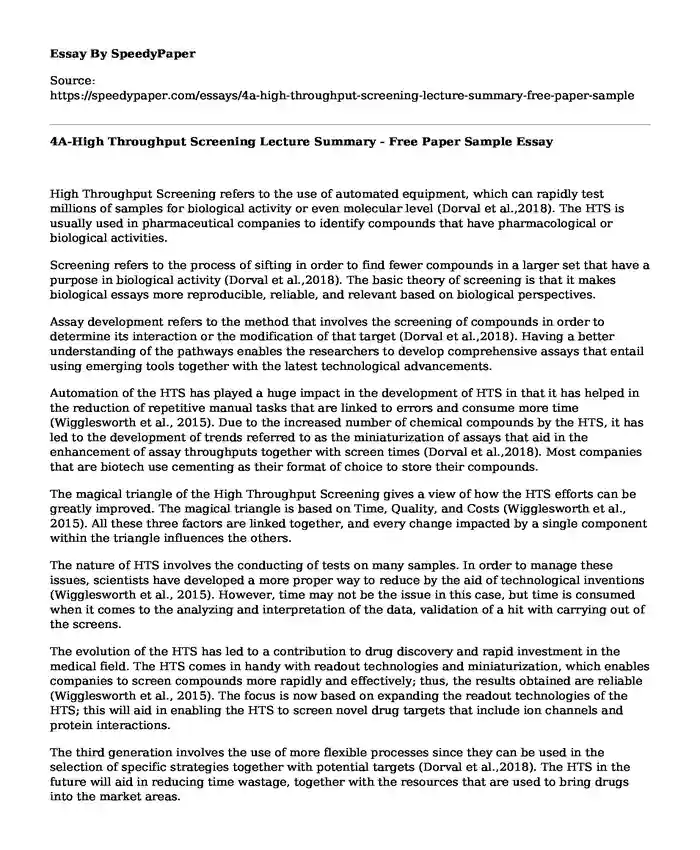
| Type of paper: | Essay |
| Categories: | Technology Drug |
| Pages: | 3 |
| Wordcount: | 620 words |
High Throughput Screening refers to the use of automated equipment, which can rapidly test millions of samples for biological activity or even molecular level (Dorval et al.,2018). The HTS is usually used in pharmaceutical companies to identify compounds that have pharmacological or biological activities.
Screening refers to the process of sifting in order to find fewer compounds in a larger set that have a purpose in biological activity (Dorval et al.,2018). The basic theory of screening is that it makes biological essays more reproducible, reliable, and relevant based on biological perspectives.
Assay development refers to the method that involves the screening of compounds in order to determine its interaction or the modification of that target (Dorval et al.,2018). Having a better understanding of the pathways enables the researchers to develop comprehensive assays that entail using emerging tools together with the latest technological advancements.
Automation of the HTS has played a huge impact in the development of HTS in that it has helped in the reduction of repetitive manual tasks that are linked to errors and consume more time (Wigglesworth et al., 2015). Due to the increased number of chemical compounds by the HTS, it has led to the development of trends referred to as the miniaturization of assays that aid in the enhancement of assay throughputs together with screen times (Dorval et al.,2018). Most companies that are biotech use cementing as their format of choice to store their compounds.
The magical triangle of the High Throughput Screening gives a view of how the HTS efforts can be greatly improved. The magical triangle is based on Time, Quality, and Costs (Wigglesworth et al., 2015). All these three factors are linked together, and every change impacted by a single component within the triangle influences the others.
The nature of HTS involves the conducting of tests on many samples. In order to manage these issues, scientists have developed a more proper way to reduce by the aid of technological inventions (Wigglesworth et al., 2015). However, time may not be the issue in this case, but time is consumed when it comes to the analyzing and interpretation of the data, validation of a hit with carrying out of the screens.
The evolution of the HTS has led to a contribution to drug discovery and rapid investment in the medical field. The HTS comes in handy with readout technologies and miniaturization, which enables companies to screen compounds more rapidly and effectively; thus, the results obtained are reliable (Wigglesworth et al., 2015). The focus is now based on expanding the readout technologies of the HTS; this will aid in enabling the HTS to screen novel drug targets that include ion channels and protein interactions.
The third generation involves the use of more flexible processes since they can be used in the selection of specific strategies together with potential targets (Dorval et al.,2018). The HTS in the future will aid in reducing time wastage, together with the resources that are used to bring drugs into the market areas.
Conclusion
Assay development can be referred to as the processes that entail the development and optimization of several variables that can get tested in order to give an individual a better reading. With the advancement in technology, the HTS has helped in reducing time and resource wastage.
References
Dorval, T., Chanrion, B., Cattin, M. E., & Stephan, J. P. (2018). Filling the drug discovery gap: is high-content screening the missing link?. Current opinion in pharmacology, 42, 40-45. https://www.sciencedirect.com/science/article/abs/pii/S1471489217302114
Wigglesworth, M. J., Murray, D. C., Blackett, C. J., Kossenjans, M., & Nissink, J. W. M. (2015). Increasing the delivery of next generation therapeutics from high throughput screening libraries. Current Opinion in Chemical Biology, 26, 104-110. https://doi.org/10.1016/j.cbpa.2015.04.006
Cite this page
4A-High Throughput Screening Lecture Summary - Free Paper Sample. (2023, Dec 13). Retrieved from https://speedypaper.net/essays/4a-high-throughput-screening-lecture-summary-free-paper-sample
Request Removal
If you are the original author of this essay and no longer wish to have it published on the SpeedyPaper website, please click below to request its removal:
- Free Essay Sample: Education for Health Delivery Systems
- Healthcare Essay Example: Value-Based Payment in Managed Care
- Cost-Effectiveness Models Essay Sample
- Essay Sample on The Application of Parse's Theory
- Paper Example. Safe Harbor Agreement
- Free Essay. an Analysis of Medicare's Solvency Issues
- E-mail Address(es). Essay Example
Popular categories




